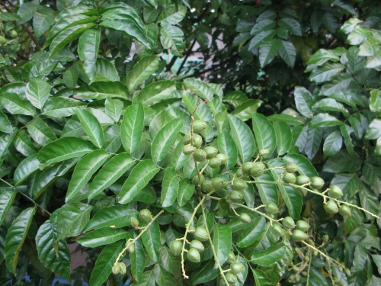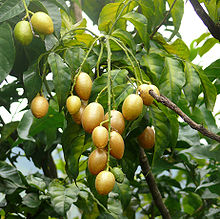Contents:
Common Names | Parts Usually Used | Plant(s) & Culture | Where Found | Medicinal Properties | Biochemical Information
Uses | Nutrient Content | Resource Links
Scientific Names

- Clausena lansium
- Clausena wampi
- Clausena punctata
- Cookia punctata
- Cookia wampi
- Quinaria lansium
- Rutaceae family
Common Names
- Fool’s Curry Leaf
- Galumpi (Philippines)
- Giôi (Vietnam)
- Hoang bi (Vietnam)
- Hong bi (Vietnam)
- Huampit (Philippines)
- Kai Sum wampee
- Kantrop (Cambodia)
- Mafai-chin (Thailand)
- Quất hồng bì (Vietnam)
- Som-ma-fai (Thailand)
- Sômz maf’ai (Laos)
- Uampi (Philippines)
- Uampit (Philippines)
- Vampi
- Wampee
- Wampi (Malaysia, Philippines)
- Wampoi (Malaysia, Singapore)
- Wang-pei (Malaysia, Singapore)
Parts Usually Used
Leaves, seeds, fruit and roots
Back to Top
Description of Plant(s) and Culture
Fool’s Curry Leaf is an evergreen tree that grows to a height of up to 20 feet. The leaves are 4 to 12 inches in length and are generally sweet-scented. The tree’s fruit that grows on stalks up to 1 inch long, are light yellowish-brown.
The white flowers bloom in late March and measure 3-4 mm in diameter. The oval fruit is about 2 cm in diameter and about 3 cm long, ripening in July and August in Florida and June to October in Southeast Asia. In Queensland Autralia, the fruit ripens in November and December.
According to Purdue University: A Chinese work translated and published in 1936, mentioned 7 varieties of Foochow, describing and illustrating 6 of them. They vary somewhat in form and size, number of seeds, season of ripening, as well as in flavor:
- ‘Niu Shen’ (“cow’s kidney”) – sour in flavor
- ‘Yuan Chung’ (“globular variety”) – sweet-subacid
- ‘Yeh Sheng’ (“wild growing”) – sour
- ‘Suan Tsao’ (“sour jujube”) – is very sour, of poor quality
- ‘Hsiao Chi Hsien’ (“small chicken heart”) – sweet subacid
- ‘Chi Hsin’ (“chicken heart”) – sweet; “best flavor of all”
- ‘Kua Pan’ (“melon section”) – sweet-subacid.
Where Found
Fool’s Curry Leaf is native to southern China, but is cultivated across Souteast Asia, Sri Lanka, Jamaica, Puerto Rico, India, Australia (Queensland), Central America and in the US (Hawaii and Florida). This tree grows best in rich loam soil.
Back to Top
Medicinal Properties
According to researchers, Fool’s Curry Leaf has been shown to contain neuroprotective properties which suggest that it may help prevent the occurrence of Parkinson’s disease. It has also shown to contain anti-inflammatory, antioxidant, antiplatelet, hypoglycemic, antifungal, antimicrobial, lipid-lowering, tyrosinase inhibitor, antidiabetic, insecticidal, hepatoprotective, and cyctoxicity properties.
Recent studies ahve shown that the peel provides strong anticancer actions against human gastric carcinoma, human hepatocellular liver carcinoma, breast MCF-7 cancer, leukemia and human lung adenocarcinoma as well. The peel extract has been shown to contain anticancer properties comparable to the anticancer drug Cisplatin.
Back to Top
Biochemical Information
The stems reportedly provide neuroprotective, anti-inflammatory, hepatoprotective, and cyctoxicity actions because of their carbazole, coumarins, amide, quinolone alkaloids, and other chemical properites.
Back to Top
Uses

In Vietnam and China, a treatment for bronchitis is prepared by cutting the immature fruits in half and sun-drying them. Thin root slices can be found in local markets there for bronchitis treaments as well.
A decoction of the leaves are used to treat dandruff and to retain hair color when the hair is washed with it.
Wampee fruit, which resemble grapes, is used to make a populare bottled, carbonated beverage in Southeast Asia. This drink is said to resemble champagne. It is made by adding sugar to the fruit, fermenting, then draining off the juice.
Wampee is used as a hedge or screening plant because of its dense foliage.
In China and Malaysia, leaves are used to treat asthma, coughs, hepatitis and skin diseases. Malaria and bronchitis are treated with the roots in Taiwan.
Ripe, peeled wampee fruit is often eaten as-is, except for the seed. This fruit is also often served in China along with meat.
The pulp of the seeded, ripened fruit is used in various desserts and fruit cups. It is also often made into jams or jellies.
According to Purdue University: The fruit is said to have stomachic and cooling effects and to act as a vermifuge. The Chinese say that if one has eaten too many lychees, eating the wampee “will counteract the bad effects. Lychees should be eaten when one is hungry, and wampees only on a full stomach”.
Nutrient Content
Fruits of this plant have been found to contain 28.8 to 29.2 mg/100 g ascorbic acid (Vitamin C).
Resource Links
Recent Studies Show Seven Herbs Help Stop Cancer Growth
Futurity.org: These Medicinal Plants Put Brakes on Cancer Growth
National University of Singapore: Anti-cancer properties uncovered in plants
University of California Riverside: Clausena lansium
Carbazole Alkaloids with Potential Neuroprotective Activities from the Fruits of Clausena lansium.
